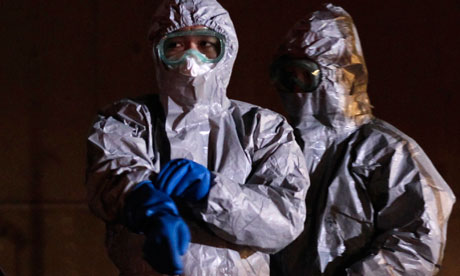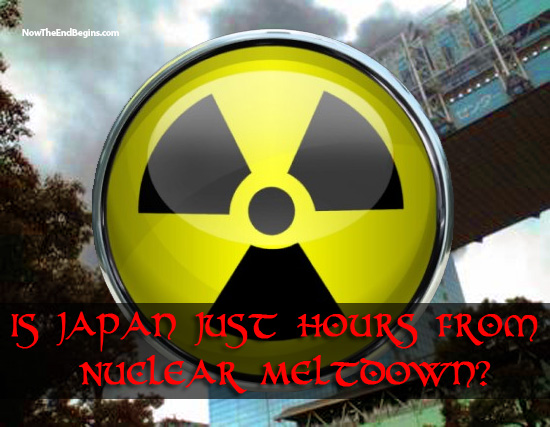 |
| Officials in protective gear at the the Fukushima nuclear plant in Japan. Photograph: Kim Kyung-Hoon/Reuters |
Yes, pray very hard!
The clock is ticking for Japan’s nuclear plants. They are unable to cool down the reactor cores to prevent a very massive meltdown.
“(Reuters) – Japanese officials may only have hours to cool reactors that have been disabled by Friday’s massive earthquake and tsunami or face a nuclear meltdown. Tokyo Electric Power Co (TEPCO) (9501.T) is racing to cool down the reactor core after a highly unusual “station blackout” — the total loss of power necessary to keep water circulating through the plant to prevent overheating.
 |
| The situation could not be more serious for Japan's three nuclear plants in wake of the massive earthquake last night |
Daiichi Units 1, 2 and 3 reactors shut down automatically at 2:46 p.m. local time due to the earthquake. But about an hour later, the on-site diesel back-up generators also shut, leaving the reactors without alternating current (AC) power. That caused Tepco to declare an emergency and the government to evacuate thousands of people from near the plant. Such a blackout is “one of the most serious conditions that can affect a nuclear plant,” according to experts at the Union of Concerned Scientists, a U.S. based nuclear watchdog group. ”If all AC power is lost, the options to cool the core are limited,” the group warned.
The emergency cooling system at a second nuclear reactor at the Fukushima power plant has failed, raising fears of serious accident but officials have said the low radiation levels pose no risk to human health
Japan is struggling to contain a growing crisis at two nuclear power plants damaged in Friday's huge earthquake and tsunami, as officials revealed that the emergency cooling system at another reactor had failed, raising fears of a serious accident.
Government officials said the negligible radioactivity levels near the plants in Fukushima prefecture posed no threat to human health. Screening centres were being set up for people worried about exposure.
Tokyo Electric Power [Tepco] decribed the situation at the Fukushima No. 1 power plant as an emergency after the cooling system failed at a second reactor at the plant.
Tepco said radioation levels at the plant had exceeded the legal limit on Sunday morning. Hourly radiation at the site was measured at 882 micro sievert, in excess of the allowable level of 500, Japan's nuclear safety agency said. The government's chief spokesman, Yukio Edano, said the level had briefly risen 1,204 micro sievert.
"There was no sudden rise in radiation because of the ventilation activities," Edano said, adding that there was no immediate threat to human health.
"We are doing the two things at the same time - venting air out of the reactor and supplying water into the reactor," he told reporters.
As authorities released steam to relieve pressure from the second overheating reactor, efforts were under way to evacuate 210,000 people living within 20 kilometres of the two plants.
Among those waiting to leave was Reiko Takagi, who lives in Iwaki, about 30 kilometres from the No. 1 plant.
"Everyone wants to get out of the town. But the roads are terrible," she said. "It is too dangerous to go anywhere. But we are afraid that winds may change and bring radiation toward us."
Edano said: "There is no confusion at this point, although we appreciate that people will have to leave their homes and livelihoods behind, but there is no panic."
Efforts were also under way to cool off three reactors at the firm's No. 2 nuclear plant in Fukushima, about 150 miles south of Tokyo.
The complete failure of more cooling systems has added an additional level of danger to what was already one of the worst nuclear accidents in Japan's history. The government has classed the accident as level four on an international scale of zero to seven.
At least 22 people are known to have been exposed to radiation and were being treated in hospital, but Japan's nuclear and industrial safety agency said that as many as 160 people may have been exposed.
Tepco confirmed that the No. 3 reactor of the quake-hit Fukushima plant had lost its cooling functions. Yesterday a small amount of radiation leaked after similar problems hit the facility's No. 1 reactor.
Nineteen people were found to have been exposed to radioactivity on Sunday; three more were exposed when the roof of a building housing the No. 1 reactor exploded the previous day.
Tepco said the No. 1 reactor had partially melted – the first time this has happened in Japan – and was continuing effort to cool the reactor with seawater, a procedure a British nuclear expert described as "an act of desperation".
The company notified the government on Sunday morning that the No. 3 reactor had lost the ability to cool the reactor core, and that radiactive steam was being released. Kyodo News quoted Tepco as saying that the up to three metres of MOX fuel rods were exposed above water at the Fukushima plant.
Shaun Burnie, an independent nuclear energy consultant and forner head of nuclear campaigns at Greenpeace, said the presence of a percentage of fuel core loaded with plutonium MOX fuel in the No. 3 reactor posed a grave threat to the surrounding area.
"Plutonium MOX fuel increases the risk of nuclear accident due the neutronic effects of plutonium on the reactor," Burnie told the Guardian. "In the event of an accident - in particular loss of coolant - the reactor core is more difficult to control due to both neutronics and higher risk of fuel cladding failure.
"In the event of the fuel melting and the release of plutonium fuel into the environment, the health hazards are greater, including higher levels of latent cancer."
The MOX fuel was delivered in 1999 and was loaded into the reactor by Tepco only last year after sitting in Fukushima storage ponds amid opposition and delays from the prefecture's governor, Burnie said.
The No. 3 reactor is the sixth facing risks because of loss of cooling water since Friday's devastating quake and tsunami.
Tepco last night filled the No. 1 reactor with seawater and boric acid to prevent criticality - or an uncontrolled nuclear reaction – hours after an explosion blew away the roof and walls of a building housing the rector.
The blast is thought to have occurred when hydrogen being released from the reactor mixed with oxygen either in the air or in cooling water.
Japan is struggling to contain a growing crisis at two nuclear power plants damaged in Friday's huge earthquake and tsunami, as officials revealed that the emergency cooling system at another reactor had failed, raising fears of a serious accident.
Government officials said the negligible radioactivity levels near the plants in Fukushima prefecture posed no threat to human health. Screening centres were being set up for people worried about exposure.
Tokyo Electric Power [Tepco] decribed the situation at the Fukushima No. 1 power plant as an emergency after the cooling system failed at a second reactor at the plant.
Tepco said radioation levels at the plant had exceeded the legal limit on Sunday morning. Hourly radiation at the site was measured at 882 micro sievert, in excess of the allowable level of 500, Japan's nuclear safety agency said. The government's chief spokesman, Yukio Edano, said the level had briefly risen 1,204 micro sievert.
"There was no sudden rise in radiation because of the ventilation activities," Edano said, adding that there was no immediate threat to human health.
"We are doing the two things at the same time - venting air out of the reactor and supplying water into the reactor," he told reporters.
As authorities released steam to relieve pressure from the second overheating reactor, efforts were under way to evacuate 210,000 people living within 20 kilometres of the two plants.
Among those waiting to leave was Reiko Takagi, who lives in Iwaki, about 30 kilometres from the No. 1 plant.
"Everyone wants to get out of the town. But the roads are terrible," she said. "It is too dangerous to go anywhere. But we are afraid that winds may change and bring radiation toward us."
Edano said: "There is no confusion at this point, although we appreciate that people will have to leave their homes and livelihoods behind, but there is no panic."
Efforts were also under way to cool off three reactors at the firm's No. 2 nuclear plant in Fukushima, about 150 miles south of Tokyo.
The complete failure of more cooling systems has added an additional level of danger to what was already one of the worst nuclear accidents in Japan's history. The government has classed the accident as level four on an international scale of zero to seven.
At least 22 people are known to have been exposed to radiation and were being treated in hospital, but Japan's nuclear and industrial safety agency said that as many as 160 people may have been exposed.
Tepco confirmed that the No. 3 reactor of the quake-hit Fukushima plant had lost its cooling functions. Yesterday a small amount of radiation leaked after similar problems hit the facility's No. 1 reactor.
Nineteen people were found to have been exposed to radioactivity on Sunday; three more were exposed when the roof of a building housing the No. 1 reactor exploded the previous day.
Tepco said the No. 1 reactor had partially melted – the first time this has happened in Japan – and was continuing effort to cool the reactor with seawater, a procedure a British nuclear expert described as "an act of desperation".
The company notified the government on Sunday morning that the No. 3 reactor had lost the ability to cool the reactor core, and that radiactive steam was being released. Kyodo News quoted Tepco as saying that the up to three metres of MOX fuel rods were exposed above water at the Fukushima plant.
Shaun Burnie, an independent nuclear energy consultant and forner head of nuclear campaigns at Greenpeace, said the presence of a percentage of fuel core loaded with plutonium MOX fuel in the No. 3 reactor posed a grave threat to the surrounding area.
"Plutonium MOX fuel increases the risk of nuclear accident due the neutronic effects of plutonium on the reactor," Burnie told the Guardian. "In the event of an accident - in particular loss of coolant - the reactor core is more difficult to control due to both neutronics and higher risk of fuel cladding failure.
"In the event of the fuel melting and the release of plutonium fuel into the environment, the health hazards are greater, including higher levels of latent cancer."
The MOX fuel was delivered in 1999 and was loaded into the reactor by Tepco only last year after sitting in Fukushima storage ponds amid opposition and delays from the prefecture's governor, Burnie said.
The No. 3 reactor is the sixth facing risks because of loss of cooling water since Friday's devastating quake and tsunami.
Tepco last night filled the No. 1 reactor with seawater and boric acid to prevent criticality - or an uncontrolled nuclear reaction – hours after an explosion blew away the roof and walls of a building housing the rector.
The blast is thought to have occurred when hydrogen being released from the reactor mixed with oxygen either in the air or in cooling water.
No comments:
Post a Comment
coment